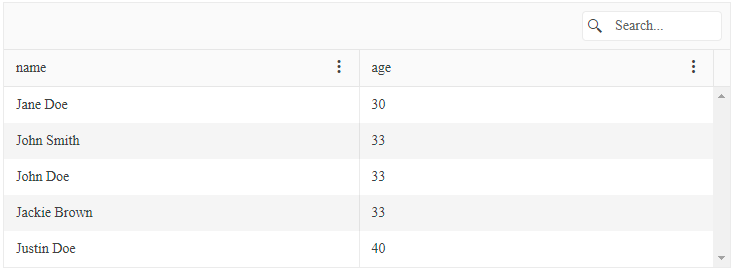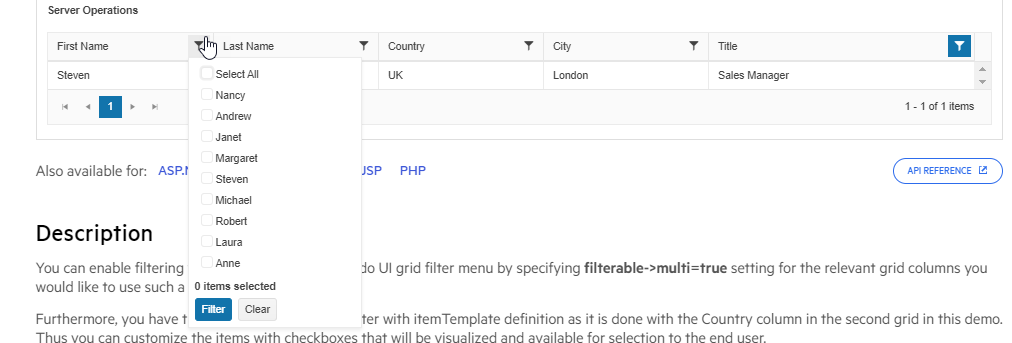Hello,
With a grid configured with the Search, if a search is carried out with pre-existing filters on non-searchable columns, the pre-filtered columns are cleared in the search result.
Consider a basic grid as per the following Dojo:
https://dojo.telerik.com/axuFURen
It is configured to search on one column - name.
I can filter on the age, to show those aged 33
With the age filter applied, I then want to search that dataset, so I enter a value in the search control.
The result is that I only get the data filtered on the search input - the age filter has been cleared.
Summary
The search control should be configurable to either combine or ignore other filters.
hi,
when filtering a column in a grid, when we type some text it searches for that text but when the column contains accented characters, we need to specify the accented character or else it will only search for normal characters.
Column with a mix of accented and normal characters values (subset)
REÉR
REÉÉ-F
REER-F
when typing re, I get all the above but if I type ree, I only get REER-F, I would like to get all 3 since E and É are the same search wise.
when typing re
when typing ree
Hi Team,
I'd like to request when a user edits a cell, to make the cell available after editing to allow it to be easily focusable though the API. This way, if the user sorts the columns, it will be available to be focused.
Thank you!
On a grid with the pager refresh button enabled, when the refresh button is clicked, it stays in the highlighted/selected animation state. Only clicking off the button and somewhere else on the page restores the button to its initial visual state.
Grid pager refresh button stuck highlighted | Kendo UI Dojo (telerik.com)
Since 2021.R3; prior versions do not animate the button on click thus do not exhibit this.
Tested in Chrome/Edge.
Bug report
In case the inline editing is enabled in the Grid and also there is a selectable column, checking/unchecking the selectable column will check/uncheck all the checkboxes on the row.
Reproduction of the problem
- Open the Dojo example.
- Click 'Edit'
- Check/uncheck the checkbox in the first column.
Current behavior
All the checkboxes on the row are checked/unchecked.
Expected/desired behavior
Only the checkbox in the selectable column should be checked without affecting the checkboxes in the other column.
The issue is a regression introduced with 2022 R1 (2022.1.119)
Environment
- Kendo UI version: 2022.2.802
- Browser: [all]
Hello
Today I noticed a bug in the GRID control.
If it applies formatting so as not to wrap the line.
Then the standard export to PDF incorrectly shows these lines too long.
I have modified this example
https://dojo.telerik.com/@p.korczak@info-kor.pl/aNOvOYIP
by adding a line
toolbar: [{name: "excel"}, {name: "pdf"}],
and see those lines where the description is too long
Paweł
Bug report
When the data in a Grid is filtered and grouped and then we try to add a new record an error is thrown
Reproduction of the problem
- Open the Dojo example.
- Filter a column (ex. filter ProductName that contains 'a')
- Group by UnitPrice
- Click the external 'add' button.
Current behavior
The following error appears in the broswer console: Uncaught TypeError: Cannot read properties of undefined (reading 'length')
The error appears no matter if dataSource.add() method or gridData.splice(0, 0, newData); is used
Expected/desired behavior
There should be no error when an item is added to the Grids dataSource
The issue is a regression starting with 2022.2.621
Environment
- Kendo UI version: 2022.2.802
- Browser: [all ]
Hi Team,
I would like to request when using a MultiCheckBox filter that if the user applies a filter to one column that only those results will be available in other columns filter menus.
For example, in the following image from the Filter Menu Checkboxes demo, if a user chooses Sales Manager, only Steven should be available. Currently, it shows all results instead:
Thank you!
Hello,
Just upgraded to 2022.2.802 Kendo UI for jQuery and noticed that when clicking on a row in a grid it correctly highlights it (e.g. dark blue), but doesn't maintain the selection when moving the mouse from the row. This appears to be a breaking change - at least for our code. Previously it would still be selected/highlighted when moving the mouse away from the row.
Cheers,
Nick
Original posted on the forum. Looks like someone else has this issue as well.
https://www.telerik.com/forums/grid-does-not-maintain-row-selection-visually-highlighted
Hi Team,
I would like to request a demo/functionality to configure the Kendo UI Grid to allow filtering with both an AutoComplete and MultiCheckBox filters. This way, the user will be able to type as they go in the AutoComplete and be able to select checkboxes of selected items.
Thank you!
Hello!
dataSource.query causes Javascript Error "Cannot read properties of undefined (reading 'length')"
just only in the new 2022.3.913 Version
see Kendo UI Snippet | Kendo UI Dojo (telerik.com)
Regards
Andreas
Description:
Screen reader dependent user will be impacted if blank column headers are defined on the table. They get no information about that column.
Test environment:
Microsoft Edge Version 105.0.1343.33 (Official build) (64-bit)
OS version (OS Build 22000.856)
URL: https://demos.telerik.com/kendo-ui/grid/aggregates?_ga=2.128136910.351146969.1663006247-1325185890.1643853544
Repro Steps:
1. Open the given URL in Edge .
2. Enable Narrator using 'Ctrl+ Win + Enter' key.
3. Navigate to the table present Aggregate page. And navigate to the column headers.
4. Observe whether Blank column header is defined on the table or not.
Actual Result:
Blank column header should not be defined on the table present on Aggregates page.
The narrator only reads its position.
Expected Result:
Appropriate name should be defined for the blank column header is defined on the table present on Aggregates page.
The narrator should also announce the same.
Additional Notes:
Same issue is observed on similar tables defined on the page.
Hello Team,
Currently, the Kendo Grid is supporting natively CheckBoxes and ComboBoxes only in the various editable modes. I would like to request a feature that allows these components to be constantly visible in the grid. So far, I have used the available Knowledge Base article, but it is inappropriate in my user case as it slows down the execution.
Thank you!
Description:
Users who rely on high contrast Aquatic/ Desert mode will be affected here as they will face difficulty in knowing which control is focused right now.
Environment (OS, Application):
Test Environment:
Microsoft Edge : Version 105.0.1343.25 (Official build) (64-bit)
OS version (OS Build 22000.856)
URL: https://docs.telerik.com/kendo-ui/api/javascript/ui/grid/configuration/filterable.messages
Pre-Requisites (if any):
1. Go to system settings.
2. Navigate to 'Accessibility' and activate it.
3. Navigate to 'Contrast theme' and activate it.
4. Select 'Desert/Aquatic' High Contrast theme in the combo box.
Repro Steps:
1. Open given URL in Edge.
2. Kendo UI for jQuery "filterable.messages" page will be open.
3. Go to preview button and activate it.
4. Turn on High contrast theme.
5. Navigate to filters and activate it. Expand 'Show items with value that:' drop drown of filters.
5. Navigate over drop drown and Observe the issue.
Actual Results:
User is not able to recognize, which list item is focused or selected in 'Show items with value that:' drop drown of filters in high contrast Aquatic/ Desert mode.
Expected Results:
A proper rectangular colorful boundary should be defined which indicates the currently selected/focused list item under the Show items with value that:' accordingly in high contrast Aquatic/ Desert mode.
Additional notes:
The same issue can be observed throughout the page where a similar dropdown appears.
Bug report
When multicolumn headers are configured in the Grid and exportSelectedToExcel method is used for exporting, a file is not always generated. The issue is reproducible when selectable is set to selectable: "multiple, cell" and cell from the first column of the multicolumn header is selected.
Reproduction of the problem
1, Open the Dojo
2. Select a single cell from the 'field1' column
3. Click the 'Export selected' button
Current behavior
No file is generated. If for example also a cell from another column is selected, then the Excel file is generated as expected
Expected/desired behavior
An Excel file should be generated as expected even if only a single cell is selected.
Environment
- Kendo UI version: 2021.2.616
- jQuery version: x.y
- Browser: [all | Chrome XX | Firefox XX | IE XX | Safari XX | Mobile Chrome XX | Android X.X Web Browser | iOS XX Safari | iOS XX UIWebView | iOS XX WKWebView ]
Bug report
When calling the exportSelectedToExcel method and passing true to it, so that the headers are also exported, a js exception related to the aggregates (count, sum, etc.) is thrown.
Reproduction of the problem
Dojo example: https://dojo.telerik.com/UkIloRag/3
- Select a few cells and click the button above the Grid.
Current behavior
A js exception is thrown.
Expected/desired behavior
No js exception is thrown and the Grid is exported as expected.
Environment
- Kendo UI version: 2022.2.621
- jQuery version: x.y
- Browser: [all]
Hi Team,
I would like to request to incorporate a Select-All checkbox which would, by default, select all items across the Kendo UI Grid pages. Additionally, it would be helpful to have this available for virtual scrolling.
Thank you!
Hi,
Currently the Selection & Export functionality does not automatically scroll down/up the Grid when the user tries to select cells that fall out of the view. Would be great if we have an option to allow automatic scroll and provide ability to choose additional cells (as in excel). Additional details are in 1576704.
We are extensively using this selection feature and the above mentioned behavior would save lot of our time and add value to the functionality.
Appreciate your support on this.
Thanks,
Raj
When I bind a change event to the grid it will fire each time I click on the row, even if it is the same row. So the selected row is not actually changing, but the event keeps firing anyways. The same thing happens if I programmatically select the row using the select method. I would rather the change event only fire when when the selection has actually changed rather than on every re-selection. Otherwise, you might as well call the event "onSelect" rather than "change". For extra points, it would be cool if the event received a reference to the previous row that was selected.
When the grid is grouped, the grouping column is visible with the same values in each cell of each group. Looks weird and confusing. How can we accomplish more efficient look and hide the grouping column? http://demos.devexpress.com/aspxgridviewdemos/GroupingSorting/Grouping.aspx Reference article: http://www.kendoui.com/forums/ui/grid/how-to-hide-the-column-the-grid-is-grouped-by-additional-grouping-questions.aspx






